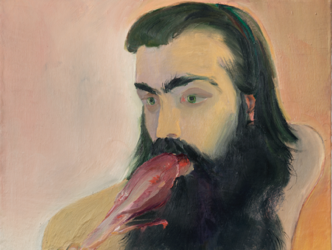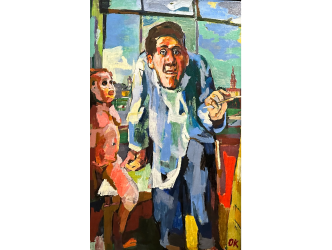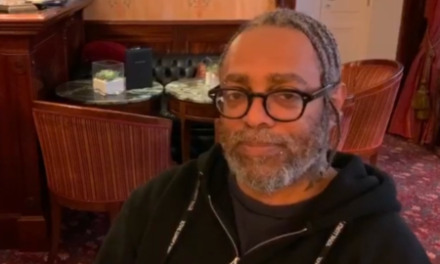Not the architecture Biennale
No, it wasn’t the architecture biennale that made me rush to Venice. I initially found it intellectually stimulating, with all the societal and ecological questions it raises, but it was weak and difficult to access in terms of the visual form these issues were given.
Palazzo Grimani
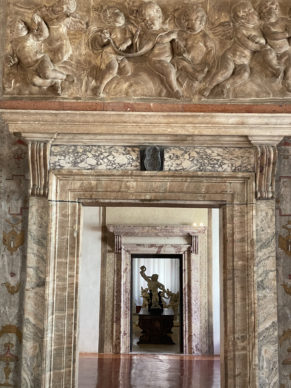
In contrast, the wonder of wonders in Venice, the new thing – or almost – that you just have to visit is a palace situated not far from the Rialto: the Palazzo Grimani.
The doge of Venice

Once upon a time there was a father, Antonio Grimani, who became the Doge of Venice in 1521, and his son Domenico, who became cardinal in 1491, immortalized in a portrait by Tintoretto. These men had real power, lots of money, and properties stretching as far as Rome.
Collection of sculptures

In 1587 the family’s array of sculptures was given to Venice to be integrated into the collections at the museum of archaeology.
Breathtakingly beautiful
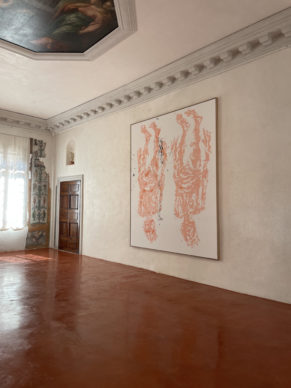
Georg Baselitz (Palazzo Grimani)
There is also a palace that used to belong to them, which was bought by the Italian state in 1981. It is a one-of-a-kind place in Venice and breathtakingly beautiful. It has been decorated in a style that is more Roman than Venetian.
Antonio da Udine

The frescoes and stucco work were contributed by Antonio da Udine, a student of Raphael. But most importantly it is here that we find the Sala della Tribuna, specially designed with its alcoves and architectural elements to house the collection of classical sculptures.
Restauration

The palace was restored, and after four centuries the array of sculptures was reintegrated into the site purposefully designed for it in May 2019. It will remain there until 27 November 2022.
Toto Bergamo Rossi
The project was made possible thanks to the intervention of the Venetian Heritage organization. Its director, Toto Bergamo Rossi, explains the project.
Georg Baselitz

Georg Baselitz
The place also displays paintings made for the site by the painter Georg Baselitz. For this new series of works, the German artist has used an imprint effect of pressing one canvas against another, similar to the monotype technique. The result adds nothing to the exceptional beauty of the palace. The Baselitz exhibition, featuring another set of new works on display from 31 October at the Fondazione Vedova in Zattere, is more interesting in this respect.
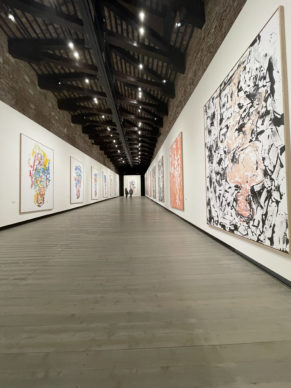
Georg Baselitz ( Fondation Vedova)
Prada Foundation
In another genre, the Prada Foundation – located, typically for Venice, in a beautiful palace – invites us to cast a retrospective eye on the various crises in painting since the invention of photography.
Skilful compilation
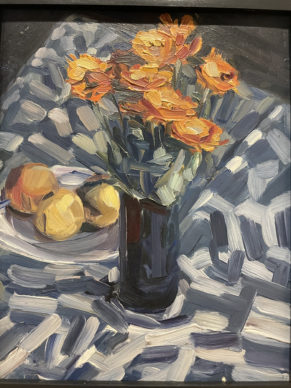
Kurt Schwitters
It is the Swiss artist Peter Fischli, from the former partnership Fischli & Weiss (David Weiss died in 2012), who has assembled a skilful compilation of all the upheavals that oil on canvas has had to face since the first rudiments of modernity.
Stop painting
The exhibition, entitled “Stop Painting”, is intelligent and encyclopaedic. Its primary virtue is to bring together in a single space everything that we have thought for a long time about this series of events, without ever truly making the links between them.
Peter Fischli
Peter Fischli’s chronology (he agreed to speak to me but not to be filmed, so I took the opportunity to film the palace, the atmosphere, and the artworks) is as follows: the biggest crisis that painting ever had to experience and, more broadly, the seismic event in art came with the invention of photography. Reality no longer needed to be interpreted through the paintbrush.
The invention of photography
It was around 1840 when the French academic painter Paul Delaroche was despairing – and he wouldn’t be the only one – when he saw photography emerge.
The ready made
Second stage: the invention of the readymade, which gave all power to the artist.
Author is dead
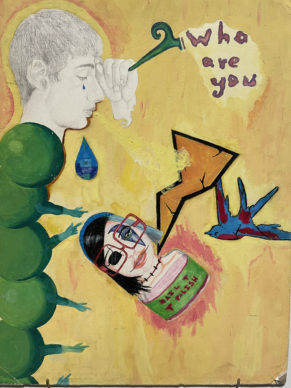
Jim Shaw
Third stage: the death of the author, or the death of the idea of the unique omnipotent author.
No more oil , no more canvas
The fourth stage tackles the medium of paint: oil on canvas and the paintbrush.
No more criticism
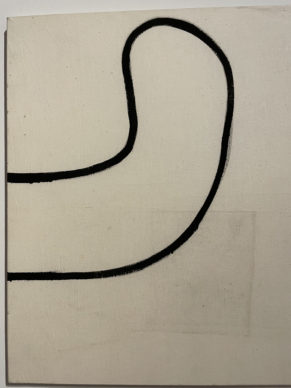
Ben Vautier
Fifth stage: the death of criticism, which permitted the artist to do whatever he deems to be relevant outside of any trends or schools and therefore… being allowed to paint again.
Little gems
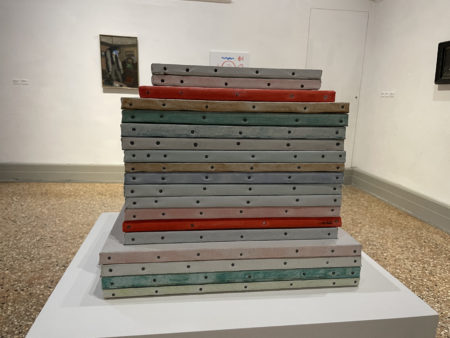
Marcel Broothaers
The exhibition features numerous little gems, such as for example when Ben, the artist from Nice, was still good and less logorrheic in 1959 and painted a banana, a black line against a white background. In 1967 when the French conceptual artist Martin Barré – his recent retrospective at the Centre Pompidou was sacrificed on the altar of Covid – made probably the first works using spray paint on canvas.
Jim Shaw
When Jim Shaw collected “amateur paintings” over a long period, which when assembled constituted an artwork since he himself is an artist. When in 1949 Francis Picabia painted spots on a monochrome canvas long before Damien Hirst …
Bruce Nauman
Lastly the third exhibition, which is just as radical, is dedicated to a specific aspect of the creation of Bruce Nauman at Punta della Dogana.
Carlos Basualdo
It is curated by Caroline Bourgeois, who is currently linked to the artistic projects of François Pinault and Carlos Basualdo, a curator at the Philadelphia Museum of Art.
Masterpiece of radical staging
It may perhaps be lacking explanatory exhibition labels, but it is a masterpiece of radical staging featuring a series of powerful installations.
Labyrinthe of videos
New converts to the work of the great Bruce Nauman should read the little booklet which is distributed at the entrance of the exhibition before venturing into the labyrinth of these offerings.
Contrapposto
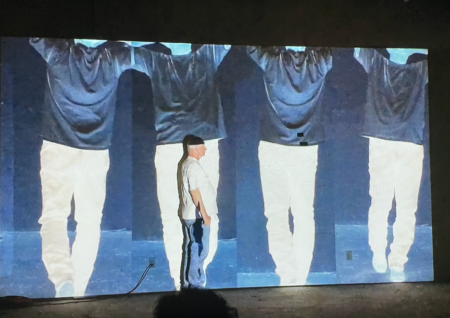
Nauman is well versed in art history, and takes as a starting point one of the poses that we find in paintings and sculptures from the Renaissance: “contrapposto”, the twist of the body that lends the subject a certain air of grace.
In a narrow corridor
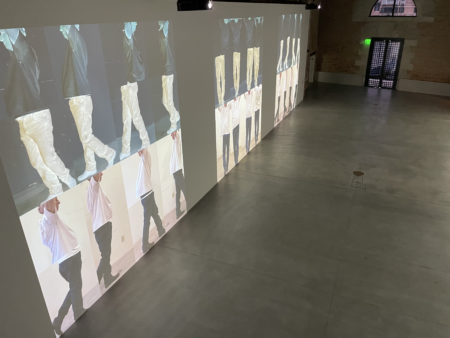
But Nauman is a creator of his time. “Since I was an artist in my studio, everything I did in the studio must be art. At that time art became more of an activity and less of a product.” So he filmed himself. We are literally immersed in repeated images of various exercises involving the artist’s “contrapposto”. In the first artwork of this kind, which dates from 1968, the artist walks with his hands behind his head in a narrow corridor.
Trapped like a rat

In French we say “être fait comme un rat” (“to be trapped like a rat”) to describe this feeling of being enclosed. Bruce Nauman has returned to this in his past pieces time and time again.
Swaying motion
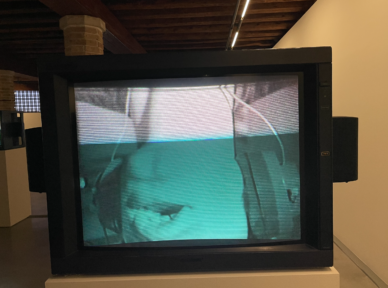
Here his approach is hampered by the self-imposed swaying motion. He revisited the idea from the 1968 video again in 2015/2016. This same moving self-portrait is cut up, taken apart and reassembled through an interplay of movements.
The age
As he walks, we also notice the subject’s aging, as he is less agile on his feet. These four contrapposto studies are projected on a giant scale, and the visit to see the artworks that are linked to this theme produce a feeling of overwhelm.
Showing grace
It leads us to think about the depiction of movement, that omnipresent subject in art history, the desire to show grace, the desire to represent, to represent its metamorphosis over time like a vanitas, the desire to include the viewer within the artwork as well.
Large spectrum of thoughts
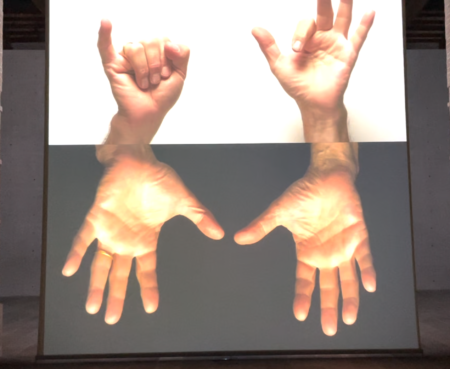
Here Bruce Nauman produces a wide spectrum of thoughts and sensations from his studio and with great economy of means. He fittingly makes an observation that could serve as an excellent conclusion:
Powerful emotional connection
“When I used to do performances, a long time ago, I made something like a list of possibilities to execute certain types of movements (…) I noticed certain positions seemed to contain powerful emotional connections.” Clearly contrapposto creates a “powerful emotional connection”. On view in Venice.
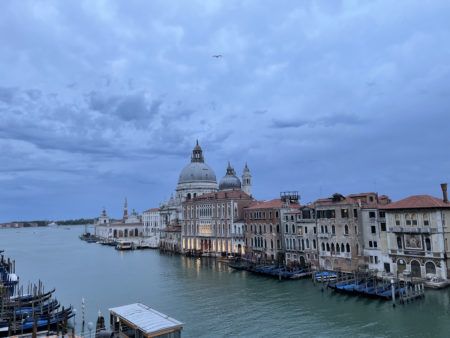
Donating=Supporting

Support independent news on art.
Your contribution : Make a monthly commitment to support JB Reports or a one off contribution as and when you feel like it. Choose the option that suits you best.
Need to cancel a recurring donation? Please go here.
The donation is considered to be a subscription for a fee set by the donor and for a duration also set by the donor.


